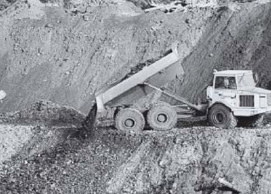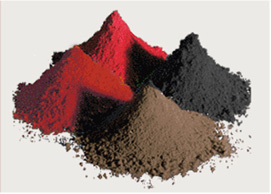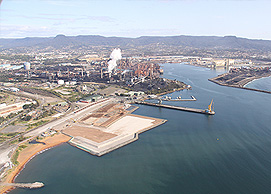BlueScope, together with a number of industry associations, aims to effectively manage by-products. In particular, the Company has worked with the World Steel Association to improve material efficiency in the steel industry worldwide.
We look at some examples of waste from BlueScope sites being used as valuable raw materials in other industries.
From waste to raw material - a sustainable and economic outcome
 For many years, New Zealand Steel sent to landfill approximately 1,600 tonnes per annum of ferric oxide, a by-product of the Acid Regeneration Plant.
For many years, New Zealand Steel sent to landfill approximately 1,600 tonnes per annum of ferric oxide, a by-product of the Acid Regeneration Plant.
Now, after investigating potential markets for ferric oxide, including as a raw material for magnetic production in China, and as a water treatment product in Australia, New Zealand Steel has signed supply contracts with a range of customers.
In the past, the ferric oxide market was considered unviable due to prohibitive packaging and logistics costs. However, New Zealand Steel’s operational and engineering teams successfully developed a packaging solution that optimises the weight of ferric oxide when bagged and loaded into a container, which is critical for keeping logistics costs low.
Since December 2009 over 95 percent of the ferric oxide produced at the Acid Regeneration Plant has been exported and sold to customers as a valuable raw material, demonstrating that New Zealand Steel’s zero waste solutions are good for our customers’ businesses, as well as our own.
Recovering waste in Malaysia
 The waste water treatment plant at BlueScope Steel Malaysia generates a significant amount of filter cake waste. Mainly comprising metals such as iron, manganese and zinc, in the past the filter cake was sent to be incinerated, and subsequently on to landfill.
The waste water treatment plant at BlueScope Steel Malaysia generates a significant amount of filter cake waste. Mainly comprising metals such as iron, manganese and zinc, in the past the filter cake was sent to be incinerated, and subsequently on to landfill.
The opening of a licensed treatment facility presented the opportunity to transform the waste into a new commercial product. In 2011, after confirmation from the Environmental Regulator that the facility would treat the waste correctly, the Company began sending filter cake to be processed into a new product which is now sold for use as bricks, pottery and pigment for paint.
The result for BlueScope Steel Malaysia is that waste is no longer sent to landfill, and instead of incurring disposal costs, the Company receives income from the sale of the processed product.
MINIMISING WASTE
 BlueScope encourages employees to minimise waste and recycle wherever possible and practical. At Lysaght Sabah this has led to the launch of a creative project.
BlueScope encourages employees to minimise waste and recycle wherever possible and practical. At Lysaght Sabah this has led to the launch of a creative project.
Concerned at increasing amounts of plastic waste, the Lysaght Sabah environment committee has engaged employees in an innovative program to recycle waste wrappers and turn them into products that can be re-used.
The wrappers are cut to size, folded into strips and arranged in an interlocking pattern which is then shaped into the desired design.
Plans are in place to run a competition for the best design using recycled wrappers.
Blast Furnace slag to Port Kembla Outer Harbour expansion

The No 5 Blast Furnace at Port Kembla Steelworks produces approximately 300kg of slag for each tonne of iron. Blast Furnace slag is formed with molten iron from iron ore in the reducing presence of heated air, coke and limestone.
Australian Steel Mill Services (ASMS), a site based contractor who manages slag processing at the Steelworks, has supplied more than 850 000 tonnes of uncrushed Blast Furnace slag to the Port Kembla Port Corporation's 6.9 hectare Outer Harbour reclamation project.
The slag was used as select fill for the harbour development, for which its excellent engineering properties are well suited.
At its peak, the slag stockpile at the Port Kembla Steelworks was almost 2 million tonnes. At the end of the Outer Harbour project, the slag stockpile had been exhausted for the first time in over 20 years.
*Photo by Colin Douch, on behalf of Port Kembla Port Corporation.
